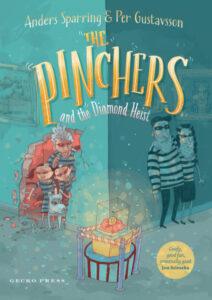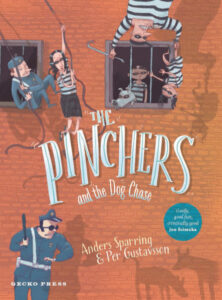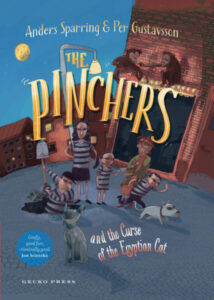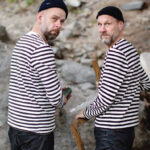 Anders Sparring writes children’s books and is a screenwriter for many popular television shows. He is also a stand-up comedian. Per Gustavsson is an illustrator and author living in Stockholm, Sweden. His bestselling books are translated into several languages.
Anders Sparring writes children’s books and is a screenwriter for many popular television shows. He is also a stand-up comedian. Per Gustavsson is an illustrator and author living in Stockholm, Sweden. His bestselling books are translated into several languages.
Who are The Pinchers books for?
Anders They are for everyone who likes to have fun. They are aimed at children aged 7–10, for reading silently and for reading aloud. We want those being read to to also have fun.
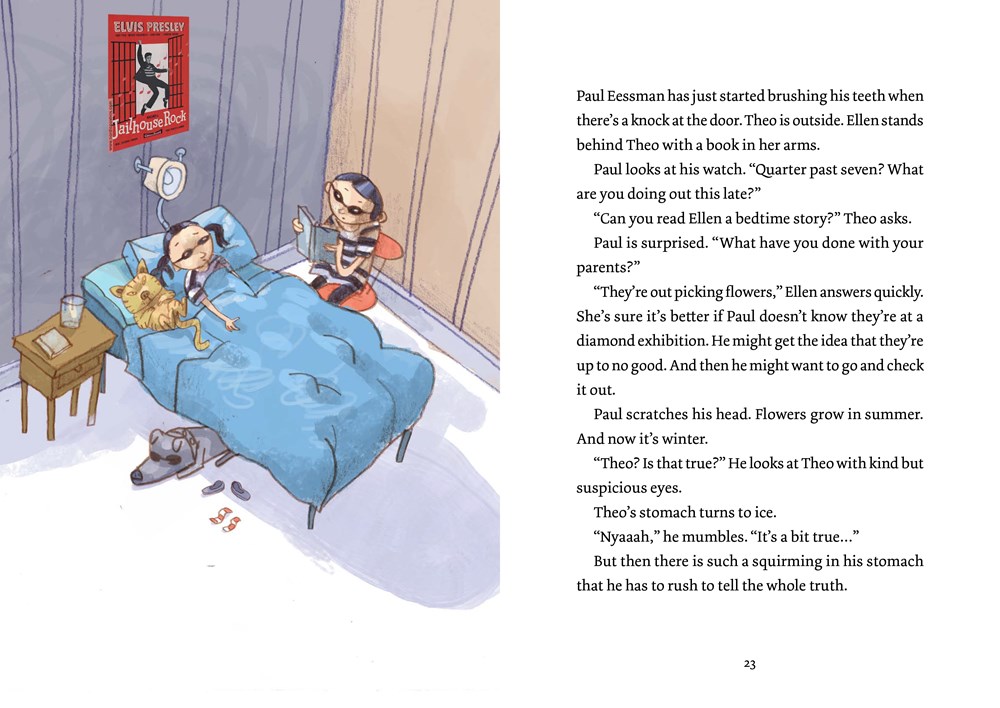
Do you identify with any particular character from the books—why?
Anders I like Theo because he worries the most.
Per Rob is definitely the most fun to draw. I think Rob is the most expressive in the family. It’s always comical when a large body tumbles down a flight of stairs or crashes through a wall. Rob is always A LOT. Then I like Sherlock. He is a silent observer. He can appear anywhere—you never know where…

What makes good comedy—is it different for children?
Anders Good comedy is based on having clear characters with clear driving forces. The humor in these books comes from the fact that the family are so incredibly different from each other but still like each other a lot. It’s not difficult to joke with children. They have full access to their humor and imagination and fewer preconceptions than adults.
Per I think adults and children can laugh at the same things. When Anders and I are out at the library,
we have a lot of fun and talk and draw with the children. We’re often in fits of laughter.
But the question “what is humor” is difficult to answer. I saw a documentary about the silent film
comedian Buster Keaton. He answered that question by saying, “I let the audience think they have
figured out where the point is going to come and then suddenly I present another humorous point.”
Humor is often about surprise.
Where do you find ideas for comedy?
Anders I always look to the characters. The question you have to ask yourself is: “What does this or that character want, and how can I create maximum difficulty for them to achieve it?”
Per I think writers and illustrators walk around with big ears and eyes. We’re scouting! Looking for comical situations and stories. They are everywhere if you look.
What comes first, character, humor or plot?
Anders Character always comes first. Then plot. If you do the job right, the humor arises by itself.
Per For me, story always comes first, starting with a basic question. It can be moral, ethical or life issues that I think about. I then find a plot, and I start thinking about who needs to be in the story to make it as clear as possible. I have written a book about how difficult it is to change your established pattern. I was looking for a character for a long time. Finally I figured out that there are hares in Sweden that change their fur in winter. It is light brown in summer then turns white in winter. All I had to do was give the hare a bad memory. Every time its fur changes, it despairs and has a crisis! So the question becomes, how will the hare handle this?
Why do you think children enjoy The Pinchers books?
Anders I think they like the books because they have warmth (you can feel that the Pincher family likes and cares for each other) and because they challenge the norm a little. The Pinchers do the forbidden, and that has tickled readers for years.
Per The children we meet love the Pinchers as much as we do. I think all stories that present a new way of looking at things are exciting. That’s why we read! To take part in adventures and fantastic things without leaving home. Many children find it exciting to imagine being with the Pincher family in their crazy backwards world. You can’t steal things and lie!
How do you work together?
We often think about the basic story together. Then Anders continues to write, calls Per, reads parts to him, and listens carefully to see if Per is laughing. When the words are finished, Per can read it and express his opinion. Then he sits down and draws. Anders has often already considered which parts work better illustrated than written.
What technique do you use to create the illustrations?
Per I almost always draw my pictures in pencil. Just plain pencil and paper. Then I scan in the image
and work on the computer with coloring and small adjustments.
The Pinchers and the Diamond Heist | Available from all good bookstores
The first in a funny chapter book crime series about a well-behaved child who doesn’t fit in to his family of criminals—featuring a prison break, a diamond heist, and a lie that saves the day.
The Pinchers and the Dog Chase | Available from all good bookstores
In this slapstick illustrated crime adventure, the honest Theo Pincher—who doesn’t fit in to his family of criminals—finds a clever way to save the family dog, Sherlock, from the nasty new police officer.
The Pinchers and the Curse of the Egyptian Cat | Coming in March 2025
Theo and his sister Ellen accidentally break an ancient cat statue and unleash a curse that turns thieves into honest people and honest people into thieves. Suddenly Ellen can’t lie and Theo is becoming a criminal. Can they break the curse?

